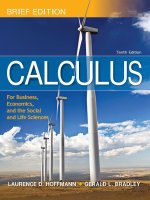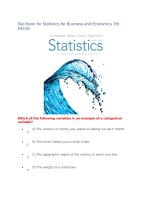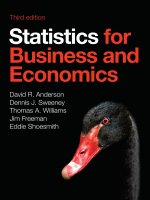Statistics for business economics 7th by paul newbold chapter 09
Bạn đang xem bản rút gọn của tài liệu. Xem và tải ngay bản đầy đủ của tài liệu tại đây (345.5 KB, 58 trang )
Statistics for
Business and Economics
7th Edition
Chapter 9
Hypothesis Testing:
Single Population
Copyright © 2010 Pearson Education, Inc. Publishing as Prentice Hall
Ch. 9-1
Chapter Goals
After completing this chapter, you should be able to:
Formulate null and alternative hypotheses for
applications involving
a single population mean from a normal distribution
a single population proportion (large samples)
the variance of a normal distribution
Formulate a decision rule for testing a hypothesis
Know how to use the critical value and p-value
approaches to test the null hypothesis (for both mean
and proportion problems)
Know what Type I and Type II errors are
Assess the power of a test
Copyright © 2010 Pearson Education, Inc. Publishing as Prentice Hall
Ch. 9-2
9.1
What is a Hypothesis?
A hypothesis is a claim
(assumption) about a
population parameter:
population mean
Example: The mean monthly cell phone bill
of this city is μ = $42
population proportion
Example: The proportion of adults in this
city with cell phones is p = .68
Copyright © 2010 Pearson Education, Inc. Publishing as Prentice Hall
Ch. 9-3
The Null Hypothesis, H0
States the assumption (numerical) to be
tested
Example: The average number of TV sets in
U.S. Homes is equal to three ( H0 : μ = 3 )
Is always about a population parameter,
not about a sample statistic
H0 : μ = 3
Copyright © 2010 Pearson Education, Inc. Publishing as Prentice Hall
H0 : X = 3
Ch. 9-4
The Null Hypothesis, H0
(continued)
Begin with the assumption that the null
hypothesis is true
Similar to the notion of innocent until
proven guilty
Refers to the status quo
Always contains “=” , “≤” or “≥ ” sign
May or may not be rejected
Copyright © 2010 Pearson Education, Inc. Publishing as Prentice Hall
Ch. 9-5
The Alternative Hypothesis, H1
Is the opposite of the null hypothesis
e.g., The average number of TV sets in
U.S. homes is not equal to 3 ( H1: μ ≠ 3 )
Challenges the status quo
Never contains the “=”
, “≤” or “≥ ” sign
May or may not be supported
Is generally the hypothesis that the researcher is
trying to support
Copyright © 2010 Pearson Education, Inc. Publishing as Prentice Hall
Ch. 9-6
Hypothesis Testing Process
Claim: the
population
mean age is 50.
(Null Hypothesis:
H0: μ = 50 )
Population
Is X= 20 likely if μ = 50?
If not likely,
REJECT
Null Hypothesis
Copyright © 2010 Pearson Education, Inc. Publishing as Prentice Hall
Suppose
the sample
mean age
is 20: X = 20
Now select a
random sample
Sample
Ch. 9-7
Reason for Rejecting H0
Sampling Distribution of X
20
If it is unlikely that
we would get a
sample mean of
this value ...
μ = 50
If H0 is true
... if in fact this were
the population mean…
Copyright © 2010 Pearson Education, Inc. Publishing as Prentice Hall
X
... then we
reject the null
hypothesis that
μ = 50.
Ch. 9-8
Level of Significance, α
Defines the unlikely values of the sample statistic if
the null hypothesis is true
Defines rejection region of the sampling
distribution
Is designated by
α , (level of significance)
Typical values are .01, .05, or .10
Is selected by the researcher at the beginning
Provides the critical value(s) of the test
Copyright © 2010 Pearson Education, Inc. Publishing as Prentice Hall
Ch. 9-9
Level of Significance
and the Rejection Region
Level of significance =
H0: μ = 3
H1: μ ≠ 3
H0: μ ≤ 3
H1: μ > 3
H0: μ ≥ 3
H1: μ < 3
α
α/2
Two-tail test
α/2
Represents
critical value
Rejection
region is
shaded
0
α
Upper-tail test
0
α
Lower-tail test
Copyright © 2010 Pearson Education, Inc. Publishing as Prentice Hall
0
Ch. 9-10
Errors in Making Decisions
Type I Error
Reject a true null hypothesis
Considered a serious type of error
The probability of Type I Error is α
Called level of significance of the test
Set by researcher in advance
Copyright © 2010 Pearson Education, Inc. Publishing as Prentice Hall
Ch. 9-11
Errors in Making Decisions
(continued)
Type II Error
Fail to reject a false null hypothesis
The probability of Type II Error is β
Copyright © 2010 Pearson Education, Inc. Publishing as Prentice Hall
Ch. 9-12
Outcomes and Probabilities
Possible Hypothesis Test Outcomes
Actual Situation
Key:
Outcome
(Probability)
Decision
H0 True
Do Not
Reject
H0
No Error
(1 - α )
Type II Error
(β)
Reject
H0
Type I Error
(α)
No Error
(1-β)
Copyright © 2010 Pearson Education, Inc. Publishing as Prentice Hall
H0 False
Ch. 9-13
Type I & II Error Relationship
Type I and Type II errors can not happen at
the same time
Type I error can only occur if H0 is true
Type II error can only occur if H0 is false
If Type I error probability ( α )
, then
Type II error probability ( β )
Copyright © 2010 Pearson Education, Inc. Publishing as Prentice Hall
Ch. 9-14
Factors Affecting Type II Error
All else equal,
β
when the difference between
hypothesized parameter and its true value
β
when
α
β
when
σ
β
when
n
Copyright © 2010 Pearson Education, Inc. Publishing as Prentice Hall
Ch. 9-15
Power of the Test
The power of a test is the probability of rejecting a null
hypothesis that is false
i.e.,
Power = P(Reject H0 | H1 is true)
Power of the test increases as the sample
size increases
Copyright © 2010 Pearson Education, Inc. Publishing as Prentice Hall
Ch. 9-16
Hypothesis Tests for the Mean
Hypothesis
Tests for µ
σ Known
Copyright © 2010 Pearson Education, Inc. Publishing as Prentice Hall
σ Unknown
Ch. 9-17
Test of Hypothesis
for the Mean (σ Known)
9.2
Convert sample result ( x ) to a z value
Hypothesis
Tests for µ
σ Known
σ Unknown
Consider the test
H0 : μ = μ0
H1 : μ > μ0
(Assume the population is
normal)
Copyright © 2010 Pearson Education, Inc. Publishing as Prentice Hall
The decision rule is:
x − μ0
Reject H0 if z =
> zα
σ
n
Ch. 9-18
Decision Rule
x − μ0
Reject H0 if z =
> zα
σ
n
H0: μ = μ0
H1: μ > μ0
Alternate rule:
α
Reject H0 if x > μ0 + Z ασ/ n
Z
x
Copyright © 2010 Pearson Education, Inc. Publishing as Prentice Hall
Do not reject H0
0
μ0
zα
μ0 + z α
Reject H0
σ
n
Critical value x c
Ch. 9-19
p-Value Approach to Testing
p-value: Probability of obtaining a test
statistic more extreme ( ≤ or ≥ ) than the
observed sample value given H0 is true
Also called observed level of significance
Smallest value of α for which H0 can be
rejected
Copyright © 2010 Pearson Education, Inc. Publishing as Prentice Hall
Ch. 9-20
p-Value Approach to Testing
(continued)
Convert sample result (e.g., x ) to test statistic (e.g., z
statistic )
Obtain the p-value
For an upper p - value = P(z > x - μ0 , given that H0 is true)
σ/ n
tail test:
x - μ0
= P(z >
| μ = μ0 )
σ/ n
Decision rule: compare the p-value to α
If p-value < α , reject H0
If p-value ≥ α , do not reject H0
Copyright © 2010 Pearson Education, Inc. Publishing as Prentice Hall
Ch. 9-21
Example: Upper-Tail Z Test
for Mean (σ Known)
A phone industry manager thinks that customer
monthly cell phone bill have increased, and now
average over $52 per month. The company wishes
to test this claim. (Assume σ = 10 is known)
Form hypothesis test:
H0: μ ≤ 52 the average is not over $52 per month
H1: μ > 52
the average is greater than $52 per month
(i.e., sufficient evidence exists to support the
manager’s claim)
Copyright © 2010 Pearson Education, Inc. Publishing as Prentice Hall
Ch. 9-22
Example: Find Rejection Region
(continued)
Suppose that α = .10 is chosen for this test
Find the rejection region:
Reject H0
α =.
10
Do not reject H0
0
1.28
Reject H0
x − μ0
Reject H0 if z =
> 1.28
σ/ n
Copyright © 2010 Pearson Education, Inc. Publishing as Prentice Hall
Ch. 9-23
Example: Sample Results
(continued)
Obtain sample and compute the test statistic
Suppose a sample is taken with the following results: n =
64, x = 53.1 (σ = 10 was assumed known)
Using the sample results,
x − μ0
53.1 − 52
z=
=
= 0.88
σ
10
n
64
Copyright © 2010 Pearson Education, Inc. Publishing as Prentice Hall
Ch. 9-24
Example: Decision
(continued)
Reach a decision and interpret the result:
Reject H0
α =.
10
Do not reject H0
1.28
0
z = 0.88
Reject H0
Do not reject H0 since z = 0.88 < 1.28
i.e.: there is not sufficient evidence that the
mean bill is over $52
Copyright © 2010 Pearson Education, Inc. Publishing as Prentice Hall
Ch. 9-25









